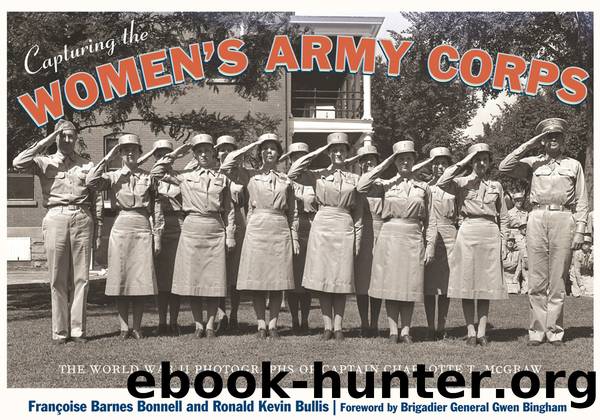Capturing the Women's Army Corps by unknow

Author:unknow
Language: eng
Format: epub
Tags: World War II, Subjects & Themes, Photography, General, Individual Photographers, Historical, Military, History
ISBN: 9780826353412
Publisher: University of New Mexico Press
Published: 2013-10-01T06:00:00+00:00
Algiers.
TOP TO BOTTOM: Manila; WAC billets in Leyte.
Captain McGrawâs photographs also showed the WACs themselves that although conditions could be challenging, they would find a way to make the best of it. The WACs worked hard, but Captain McGraw made sure that these women knew they also would be afforded the opportunity to do some sightseeing and shopping for a bit of rest and recuperation. Some WACs serving overseas were able to benefit from their host countryâs traditions. Captain McGraw ensured that the public, families, potential recruits, and the WACs themselves knew that it was possible to have some normalcy even in the middle of a war on foreign soil. Perhaps this would make the women on the home front somewhat envious?
Captain McGrawâs pictures of WACsâ living quarters and their daily life showed the public that these women were not on the front lines and in fact were very well taken care of by the army. The photographs showed how WACs ingeniously made their homes âcozyâ even though they lived in canvas tents and slept on army cots. The WACs being photographed were sometimes posed so that Captain McGraw could relay the message the army wanted to convey. Thus, her subjects were always neat in their attire, and their makeup and hair appeared perfect so they looked none the worse for the work and service they were providing in harsh environments.
We know from numerous firsthand accounts of these women who served in the Southwest Pacific, Indian/Burmese, African, and European theaters that life was not always easy for them. Some were sent to the tropics with winter uniforms and contracted skin diseases as a result. Others were sent to very cold climates, where some reported that they could never get fully warm. Nevertheless, the images Captain McGraw produced did not convey these realities. Instead, her photographs showed some of the more positive aspects of service in the army and the normal routine of WACsâ lives. Whether they were eating three regular meals a day, relaxing at a United Services Organization (USO) show, or picking up their mail, life could be considered ordinary.
Captain McGrawâs photographs are a priceless treasure. These images, which were used extensively for publicity by the War Department and always carried a positive message, had a profound influence on public opinion and attitudes about women serving in the army in World War II. Today, her collection is valuable not only in preserving the history of women in army service during the war, but also in helping to uncover previously unknown details about that history. Undoubtedly Captain McGraw knew the importance of her work at the time and, thankfully, had the foresight to donate her materials to a museum to become part of the public record and dialogue about the role of women in the army.
Download
This site does not store any files on its server. We only index and link to content provided by other sites. Please contact the content providers to delete copyright contents if any and email us, we'll remove relevant links or contents immediately.
| African | Asian |
| Australia & Oceania | Canadian |
| Caribbean & Latin American | European |
| Jewish | Middle Eastern |
| Russian |
The Hating Game by Sally Thorne(19112)
The Universe of Us by Lang Leav(15006)
Sad Girls by Lang Leav(14311)
The Lover by Duras Marguerite(7820)
The Rosie Project by Graeme Simsion(6185)
Smoke & Mirrors by Michael Faudet(6129)
Big Little Lies by Liane Moriarty(5699)
The Shadow Of The Wind by Carlos Ruiz Zafón(5638)
The Poppy War by R. F. Kuang(5566)
An Echo of Things to Come by James Islington(4751)
Memories by Lang Leav(4748)
What Alice Forgot by Liane Moriarty(4566)
From Sand and Ash by Amy Harmon(4386)
The Poetry of Pablo Neruda by Pablo Neruda(4038)
The Tattooist of Auschwitz by Heather Morris(3792)
Ficciones by Jorge Luis Borges(3567)
Guild Hunters Novels 1-4 by Nalini Singh(3406)
The Rosie Effect by Graeme Simsion(3372)
THE ONE YOU CANNOT HAVE by Shenoy Preeti(3291)
